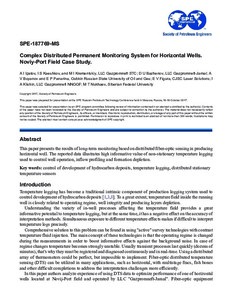Complex Distributed Permanent Monitoring System for Horizontal Wells. Noviy-Port Field Case Study
Скачать файл:
DOI:
10.2118/187769-MSURI (для ссылок/цитирований):
https://www.onepetro.org/conference-paper/SPE-187769-MShttps://elib.sfu-kras.ru/handle/2311/111377
Автор:
Ipatov, A. I.
Kaeshkov, I. S.
Krementskiy, M. I.
Bazhenov, D. U.
Buyanov, A. V.
Panarina, E. P.
Figura, E. V.
Klishin, I. A.
Нухаев, М. Т.
Коллективный автор:
Институт нефти и газа
Кафедра разработки и эксплуатации нефтяных и газовых месторождений
Дата:
2017-10Журнал:
Society of Petroleum EngineersКвартиль журнала в Scopus:
без квартиляБиблиографическое описание:
Ipatov, A. I. Complex Distributed Permanent Monitoring System for Horizontal Wells. Noviy-Port Field Case Study [Текст] / A. I. Ipatov, I. S. Kaeshkov, M. I. Krementskiy, D. U. Bazhenov, A. V. Buyanov, E. P. Panarina, E. V. Figura, I. A. Klishin, М. Т. Нухаев // Society of Petroleum Engineers: SPE Russian Petroleum Technology Conference. — 2017. — С. 1-11Текст статьи не публикуется в открытом доступе в соответствии с политикой журнала.
Аннотация:
Application of distributed temperature systems (DTS) and distributed acoustic systems (DAS) for continuous monitoring and surveys of horizontal wells demonstrated with the case study of horizontal oil well at Novoportkovskoe oil and gas condensate field. This paper presents the results of long-term monitoring based on distributed fiber-optic sensing in producing horizontal well. The reported data illustrates high informative value of non-stationary temperature logging used to control well operation, inflow profiling and formation depletion.

